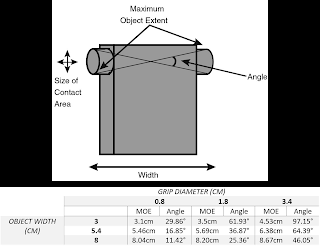I have reviewed the spatial and temporal structure of reach-to-grasp movements, and the task dynamical analysis that has connected affordance properties and reach-to-grasp effectivities. Now it's time to work through some papers exploring this task using this analysis.
The first paper is Mon-Williams & Bingham (2011). The goal of this paper was to investigate what target properties shape the spatial structure of the reach-to-grasp movement. This means the behavior of the hand as it forms a grip aperture and then encloses and contacts the object. Specifically, we want to examine the maximum grip aperture (MGA), which occurs partway through the reach and is larger than the object, and the terminal grip aperture (TGA), which occurs when the hand has stopped moving and the hand encloses the object, but before the fingers are in contact with the object. The question is, what object properties determine how these apertures are scaled?
Design
Independent Variables
Targets were placed at a constant 30cm distance from the hand's start location, directly in front of the participant. Targets were all 9cm high, and 4cm deep, with a dowel inserted through the top to create landing sites. They varied in Width (3 levels) and Grip Area (3 levels); there were therefore 9 different objects, each with a corresponding maximum object extent (MOE). See Figure 1.
| Figure 1. Maximum Object Extents and Angles for each of the 9 targets |
The maximum object extent is the hypotenuse of a right-angled triangle, with Object Width and Dowel Diameter as the other two sides. This has a useful feature: it makes the relationship between MOE and Width non-linear, which will help us tell their effects in grip apertures apart later on. One final factor was Reach Speed (Normal, Slower, Faster). These were self paced and different for each participant, but reliably produced by each participant. This is a typical way to manipulate things when studying affordances: people will all have a different normal/comfortable speed so setting specific speeds as targets will affect people differently. This way, everyone is reaching in similar ways relative to their abilities/intrinsic dynamics. It is an assumption, though, so worth testing in the future. Participants made 10 reaches in each object condition (3 Widths x 3 Grasp Surface Size x 3 Speeds) for a total of 270 reaches. Dependent Variables
Three markers were placed on the participant's hand; one on the wrist, on on the thumb, one on the index finger. From these position time series we can compute all the relevant spatial and temporal features of the reach-to-grasp action. Hand movement beginning and end were set as the times when the wrist marker speed first rose above and then first fell below 5cm/s (a threshold that copes with measurement error and small movements in an essentially still wrist). There was also a marker on the target, used to confirm it was not moved.The grip aperture is the distance between the thumb and finger markers. This reaches a maximum (the MGA) and also has a value when the wrist stops (the TGA). This aperture, if treated as a vector, also has an orientation in the roll axis; this is the Angle. All variables were averaged across the 10 repetitions.Analysis
The primary analysis used was multiple regression, trying to predict average Maximum Grip Aperture, Terminal Grip Aperture, and TGA Orientation. Factors included were Grasp Surface Size, Width, Maximum Object Extent, Angle, and Speed (coded as -1, 0, +1). Two regression models were applied:- Affordance properties: MOE, Angle, Speed, MOE x Speed, Angle x Speed, MOE x Angle
- Basic Properties: Grasp Surface Area, Width, Speed, Grasp x Speed, Width x Speed, Grasp x Width
In each analysis, non-significant factors were removed until only significant factors remained. The goal is to see which object properties are required to explain variability in the spatial structure of the grip. Experiment 1 - Reach-to-Grasp Upright Objects Without Moving Them
TGA Grip Orientation
The only significant factor was maximum object extent. As MOE increased, Angle decreased, and there was structure in the variability: standard deviations of the orientation were larger for larger angles. See Figure 2 in the paper. This result doesn't quite make sense to me; the available Angle range doesn't scale linearly with MOE and so it's strange to me that the grip aperture orientation is scaling with MOE and not Angle. I suspect it will be worth looking into this aperture orientation in finer detail throughout the reach. However, one key result is that there is plenty of variability in the aperture orientation, which confirms it is a degree of freedom that needs to be controlled and that maximum-object-extent really is likely to be an important object property.Maximum Grip Aperture Size
The primary finding was the MGA was scaled as a function of the Maximum Object Extent, and with Speed (bigger MGA for larger MOE and higher Speed). In the regression, the significant terms were MOE, Speed, and MOE x Speed. See Figure 3 in the paper. MGA is a simple linear function of the MOE, with a Speed specific safety margin added in (each condition added about 11% to the margin, a nice result suggesting the speed manipulation was working as intended). Terminal Grip Aperture
The primary finding was that the TGA was scaled as a function of Object Width (bigger TGA for wider objects) and Speed (smaller TGA for higher Speeds). In the regression, the significant terms were Width, and Speed x Grasp Surface Area. See Figure 3 in the paper (note that it's a busy figure - a Bingham classic. Just pay careful attention to the legend and caption). TGA is a simple linear function of Object Width, with a decreasing safety margin as Speed increased. Experiment 2: Reach-to-Grasp and Lift
This replicated the design of Expt 1, but with the added instruction that the objects were to be picked up. There are two solutions to this version; simply add a lift to the patterns seen in Expt 1, or pick the objects up without slowing to a stop. Participants produced both solutions; fly-throughs were more common for large Angles (an easier grasp task) and for higher speeds (saves slowing down). Only grasp dynamics mattered for this decision, it seemed.Trials were split as a function of whether people Stopped or Flew Through. Stop trials are the reach solution seen in Expt 1, so these were checked to see if they replicated that pattern. All the results from above replicated in these trials. Fly Through trials don't have a TGA (the wrist never stops moving) so they compared the MGA orientation and size behavior. They could only use the Medium speed condition, as there were too few fly throughs at low speeds and too few stops at high speed. In both types of reaches, though, the results were the same. MGA orientation varied only with MOE. MGA size varied with MOE and Angle, although the latter only explained 0.7% of the variance. Fly through and Stop trials were, then, basically the same structure with the former 15% faster. The spatial structure of both reach types are responding to the same task dynamics.Experiment 3: Slam
One of the things that had inspired this study was the fact that reach-to-grasp is often studied with objects lying down on the table. This removes the collision avoidance dynamics, as the object can't be knocked over, and the MOE only emerges as a relevant affordance property from those dynamics. In addition, the hand can simply be stopped by the table, so the whole task structure changes. A third experiment looked to see what this set up does to the spatial structure of reaches.In this study, objects of 5 different lengths were placed on flat on the table and participants had to grasp them (no lifting) along that length, at one of three speeds. (It's unclear why the objects and grasp task were altered in this way.) Under these conditions, MGA increased with Object Size (not MOE) and with Speed. TGA again increased with Object Size and decreased with Speed. In addition, the safety margins were reduced and (for larger objects) essentially zero. Collision-avoidance is not a dynamic for reaches under these conditions; in fact, participants simply took advantage of being able to use the table to stop their fingers, rather than slowing the wrist and placing the fingers. The change in task dynamic produced qualitatively different reaches. Summary
There's a ton going on in this paper and I still haven't covered it all. The goal here was just to go over the basic methods, analyses, and design issues. The first key move was to test the (actually typical) case of reaching to grasp an object you could knock over (following Rosenbaum et al, 1999). The second was to split out the various task dynamics and relating them to different parts of the reaching behavior. The net result: the maximum object extent is a key property picked out by the collision-avoidance dynamics, and it's what the maximum grip aperture is scaled by. Remove those dynamics (Expt 3) and the only relevant property is object size; MGA is then scaled by that. Adding a lifting component (Expt 2) creates the possibility of two different responses (Stop vs Fly Through) but it doesn't seem to affect the transport then grasp while avoiding collision dynamics (both kinds of reach behave the same up until contact with the object). I'm still trying to figure out why the grip orientation was affected by MOE the way that it was. It seemed obvious that it should be being constrained by the Angle defined by the MOEs (see Figure 1), but it wasn't. The next trick is to figure out the form of a UCM/TNC analysis.


